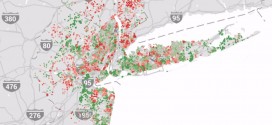A majority of the nation’s largest markets, 52 percent, have now recovered more than half of the equity they lost during the Great Recession, according to the latest Rebound Report from Homes.com.
For the fourth consecutive month, all of the 200 midsize local markets measured continued to show gains year over year for the single-family index in October. While the number of top 100 markets achieving a full recovery remained flat from the previous month, there was noticeable improvement in the number of these markets pertaining to overall recovery. Three markets moved out of the 0-25% rebound range, and three markets moved up in the 75-100% rebound range.
Month-over-month increases in index values were seen in 251 of the top 300 markets, down from 253 the previous month. The slight downtrend is likely due to both seasonal trends and the state of recovery for these markets. Of the 49 markets that saw declines last month, 18 have fully recovered their decline in home prices from the housing bubble and show signs of continuing stabilization.
Seasonal downtrends, along with market stabilization, continued to trend at the end of the third quarter increased month to month – slightly down by three from last month’s report. However, the month-to-month declines displayed by 39 markets are relatively nominal, with the largest decrease being -0.93 index points in Lynchburg, Va.
“As we end the third quarter, both large and small markets that previously achieved full price recovery from the housing depression consolidated their gains reached during the home buying season. One in four surpassed their pre-recession peak values,” said Brock MacLean, executive vice president of Homes.com. “These price gains are restoring millions of homeowners to positive equity and are reviving local real estate markets across the country.”
The latest Homes.com Local Market Index reports:
- Year-over-year increases in all top 300 markets.
- Monthly increases in 90 of the top 100 markets and in 161 of the 200 midsized markets.
- Honolulu, Hawaii remains the top gaining market on a year-over-year basis, with a 28.88 index point or 13.07 percent increase.
- California markets [Los Angeles-Long Beach-Santa Ana, Calif.; San Diego-Carlsbad-San Marcos, Calif., San Francisco-Oakland-Fremont, Calif.; Bakersfield-Delano, Calif.] are the remaining 4 in the top 5. Year-over-year, they increased 26.73, 25.98, 25.41 and 20.32 index points, respectively, but are only an average of 32 percent back to recovery.
- All of the top 10 monthly gaining markets from the top 100 are in the West, up from nine in the previous month and six in the month prior to that.
Highlights from the Homes.com Rebound Report for the top 300 markets show:
- 80 have made more than a 100 percent rebound, indicating a complete recovery in these markets. This is an increase from 77 markets in the previous reporting period.
- The three newest markets to achieve a full rebound are Davenport-Moline-Rock Island, Iowa-Ill., Santa Fe, N.M. and Jefferson City, Mo.
- 152 show more than a 50 percent rebound, up from 143 markets in the previous month.
- 24 percent (19) of the 80 fully rebounded markets reported month-over-month losses, and the remaining averaged 1 percent gains month-over-month compared to .75 percent gain in non-recovered markets. This illustrates the seasonal downtrend in the housing market along with a leveling of home prices.
- 22 markets were not affected by the boom-bust scenario of the U.S. housing bubble. These markets did not experience the same peak-to-trough decline displayed by the remaining 278 markets. All of these markets are midsize markets, with half from the state of Texas and 73 percent from energy-producing areas. They include: Brownsville-Harlingen, Texas; Killeen-Temple-Fort Hood, Texas; Shreveport-Bossier City, La.; Anchorage, Alaska; Fayetteville, N.C.; Charleston, W.Va.; Lubbock, Texas; Cedar Rapids, Iowa; Amarillo, Texas; Waco, Texas; College Station-Bryan, Texas; Longview, Texas; Tyler, Texas; Fargo, N.D.-Minn.; Jacksonville, N.C.; Monroe, La.; Waterloo-Cedar Falls,
To provide insight into local market housing trends across the country, Homes.com publishes the Local Market Index for the Top 100 markets and the companion Midsize Markets Report for markets ranked from 101-300. To complement to the Local Market Index, Homes.com publishes an exclusive Rebound Report, highlighting how the housing recovery process is unfolding across the country. The report measures each market’s peak-to-trough decline in index value, which had been attributed to the bursting of the U.S. housing bubble.
 RealEstateEconomyWatch.com Insight and Intelligence on Residential Real Estate
RealEstateEconomyWatch.com Insight and Intelligence on Residential Real Estate



One comment
Pingback: Fifty-two Percent of Largest Markets Have Recovered Half of Lost Equity | Belair Realty